#aeration tubes
Text
Understanding the Factors Affecting Dissolved Oxygen Levels in Aquaculture Ponds
Dissolved oxygen (DO) is a crucial parameter in aquaculture ponds, directly influencing the health, growth, and survival of aquatic species such as fish, shrimp, and other marine life. Proper management of DO levels is essential to ensure a healthy environment, promoting efficient production and minimizing losses. Various factors impact DO levels, and understanding these is key to maintaining a balanced and productive pond ecosystem. This blog will explore the factors affecting DO levels in aquaculture ponds, with a focus on how the type of marine life stocked influences oxygen dynamics.
1. Temperature
Temperature is a fundamental factor that affects dissolved oxygen levels in water. As water temperature increases, the solubility of oxygen decreases. Warmer water holds less oxygen, which can be problematic during hot weather when DO levels may drop to critical levels. Additionally, higher temperatures increase the metabolic rates of fish and shrimp, leading to higher oxygen consumption.
In ponds with higher temperatures, it becomes essential to monitor DO levels closely, especially during the summer months. Aeration systems can help mitigate the effects of temperature on DO by enhancing oxygen diffusion and water circulation.

2. Salinity
Salinity, or the concentration of dissolved salts in water, influences the solubility of oxygen. Higher salinity reduces the amount of oxygen that can be dissolved in water, which is particularly relevant in brackish water ponds used for shrimp farming or marine aquaculture. As salinity increases, DO levels decrease, making it crucial to monitor and manage salinity levels effectively.
In areas where freshwater availability is limited, maintaining the balance between salinity and DO is vital. Proper aeration and water exchange practices can help maintain adequate oxygen levels in high-salinity environments.

3. Photosynthesis and Respiration
Aquatic plants, algae, and phytoplankton contribute to oxygen dynamics in ponds through photosynthesis and respiration. During the day, these organisms produce oxygen, which can increase DO levels. However, at night, they consume oxygen through respiration, potentially leading to decreased DO levels.
Ponds with dense algal blooms may experience significant diurnal fluctuations in DO levels. These fluctuations can stress aquatic life, particularly during early morning hours when oxygen levels are lowest. Managing algal growth and ensuring adequate aeration are important to stabilize DO levels.

4. Organic Matter and Decomposition
The accumulation of organic matter, such as uneaten feed, fish waste, and dead plant material, contributes to oxygen consumption through decomposition. Microbial activity breaks down this organic matter, consuming large amounts of oxygen in the process. High levels of organic matter can lead to oxygen depletion, especially in the bottom layers of the pond.
Effective pond management practices, such as regular sludge removal and the use of high-quality feed, can help reduce organic matter buildup and maintain higher DO levels. Aeration also supports aerobic decomposition, which is more efficient and less harmful to aquatic life.
5. Stocking Density
Stocking density, or the number of fish, shrimp, or other organisms in a pond, directly affects oxygen demand. Higher stocking densities increase the overall oxygen demand, which can lead to lower DO levels if not managed properly. In intensive aquaculture systems, careful monitoring and management of DO levels are essential to prevent oxygen-related stress.
Balancing stocking density with available oxygen resources is crucial for maintaining healthy and productive ponds. Regular monitoring and adjustments to aeration and feeding practices can help ensure that oxygen supply meets the demand.
6. Water Movement and Circulation
Water movement and circulation are critical for maintaining uniform DO levels throughout the pond. In stagnant ponds, oxygen tends to stratify, with higher concentrations near the surface and lower concentrations at greater depths. This stratification can create oxygen-depleted zones, particularly at the bottom of the pond.
Aeration and circulation systems help mix the water, distributing oxygen more evenly. Proper water movement also prevents the formation of "dead zones" where oxygen levels are too low to support aquatic life. Regular operation of aeration systems during critical periods is essential for maintaining optimal DO levels.
7. Feeding Practices
Feeding practices significantly impact DO levels in aquaculture ponds. Overfeeding can lead to the accumulation of uneaten feed, which increases organic matter and oxygen consumption through decomposition. Additionally, the metabolic activity of fish and shrimp increases during feeding, temporarily raising their oxygen demand.
Using high-quality feed, feeding in appropriate quantities, and scheduling feedings during cooler parts of the day can help minimize the impact on DO levels. These practices contribute to more stable oxygen levels and healthier aquatic life.
8. Weather Conditions
Weather conditions, including wind, rain, and atmospheric pressure, influence DO levels in aquaculture ponds. Wind promotes surface agitation and mixing, enhancing oxygenation. Rain can either increase or decrease DO levels, depending on its intensity and temperature. Atmospheric pressure also affects oxygen solubility, with lower pressure reducing DO levels.
Weather-related fluctuations in DO levels can be managed through the use of aeration systems and careful monitoring of weather patterns. Anticipating changes in weather and adjusting pond management practices accordingly can help maintain stable DO levels.
9. Pond Depth and Area
The physical characteristics of the pond, such as its depth and surface area, affect oxygen diffusion and distribution. Shallow ponds generally have better oxygenation at the bottom due to easier mixing by wind and aeration. However, they are more susceptible to temperature fluctuations. Deep ponds may experience stratification, with oxygen-depleted zones forming at greater depths.
Proper pond design and management, along with strategic placement of aerators, can help maintain adequate DO levels throughout the pond. Regular monitoring of DO at different depths ensures that all areas of the pond remain well-oxygenated.
10. Water Quality Parameters
Water quality parameters, including pH, ammonia, nitrite, and nitrate levels, influence dissolved oxygen availability. High levels of ammonia and nitrites are toxic to aquatic life and increase oxygen demand. The conversion of ammonia to nitrate through nitrification consumes oxygen, further reducing DO levels.
Maintaining optimal water quality through regular monitoring and management is crucial for preventing oxygen depletion. Aeration supports nitrification processes, helping to control toxic compounds while maintaining sufficient DO levels.
11.Type of Marine Life Stocked
The specific type of marine life stocked in the pond—whether fish, shrimp, seaweed, or other species—significantly affects DO levels. Different species have varying oxygen requirements and contribute differently to the pond's oxygen dynamics.
Fish: Fish, especially species like tilapia or catfish, typically have moderate to high oxygen demands. They are active swimmers and require well-oxygenated water to thrive. Higher stocking densities of fish can lead to greater oxygen consumption, necessitating efficient aeration systems.
Shrimp: Shrimp, particularly in high-density farming, also have significant oxygen requirements. They are more sensitive to low DO levels and are prone to stress and mortality if oxygen levels drop too low. Shrimp farming often requires precise aeration management to maintain optimal DO levels.
Seaweed: Seaweed and other aquatic plants contribute to oxygen production during the day through photosynthesis. However, they also consume oxygen at night through respiration. While seaweed can help increase DO levels during daylight, it can contribute to oxygen depletion at night, especially in densely planted ponds.
Understanding the oxygen requirements of the specific species stocked in your pond is crucial for effective DO management. Tailoring aeration and management practices to the needs of your stock helps create an environment conducive to growth and productivity.
Conclusion: Optimizing Dissolved Oxygen Levels for Aquaculture Success
Maintaining optimal dissolved oxygen levels in aquaculture ponds is essential for the health, growth, and productivity of aquatic species. By understanding and managing the factors that influence DO levels—such as temperature, salinity, organic matter, stocking density, and the type of marine life stocked—you can create a balanced and oxygen-rich environment that supports the well-being of your stock.
Neglecting DO management can lead to serious consequences, including stressed and weakened aquatic animals, reduced growth rates, increased disease susceptibility, and even mass mortalities. Therefore, adopting a proactive approach to monitoring and maintaining DO levels is critical. This includes regular use of aeration systems, careful feeding practices, and vigilant observation of water quality parameters.
To assist you in maintaining the right oxygen levels, Airoxi offers a Dissolved Oxygen Calculator on their website. This tool helps you determine the proper aeration requirements based on your specific pond conditions, ensuring that you provide the ideal environment for your fish, shrimp, or other marine life. I highly encourage you to visit www.airoxi.com/calculator https://www.airoxi.com/calculator to use this valuable resource and optimize your aquaculture operation for success.
By leveraging accurate aeration calculations and sound pond management practices, you can ensure that your aquaculture venture thrives, providing healthy and productive yields year-round.
Contact AirOxi for your aquaculture aeration requirements
+917041004098
www.buy.airoxi.com
#airoxitube #airoxi #airoxidiffuser #airoxiproducts #aquarium #aquaculture #fishing #fishingfarm #shrimp #shrimptank #fishtank #tank #RAS #aeration #aerationsystem #bubbles #bubble #post #postoftheday #oxygenation #hatcheries #shrimpfarm #aqualife #blower #microbubblegenerator #transportationaeration #turbineblower #submersibleaerator #biofloc #growoutponds #nurseries #oxygenconcentrator #diffuser # #NFDB and #national fisheries development board
#fish farming#shrimp farming#aquaculture#aeration solution#airoxi#fish#aeration#aeration tubes#airoxitube#airoxi tube
0 notes
Text

PROMO KILAT DIFFUSER FINE BUBBLE HUB:(081335353290)
Difuser fine bubble adalah perangkat inovatif yang menghasilkan gelembung udara sangat kecil dalam cairan. Dengan ukuran yang mikroskopis,
difuser ini memaksimalkan transfer oksigen ke dalam air dengan efisiensi tinggi. Dengan menyebarkan udara ke dalam gelembung-gelembung halus,
difuser ini menciptakan area kontak yang luas antara udara dan cairan, meningkatkan proses oksigenasi dan sirkulasi. Kemampuan difuser fine bubble
dalam menciptakan gelembung kecil memperbaiki kualitas air, mendukung pertumbuhan organisme air, serta membantu dalam pengolahan air limbah. Perangkat
ini diakui karena efisiensinya dalam meningkatkan lingkungan akuatik sambil mengurangi dampak lingkungan yang merugikan.
Untuk pembelian bisa anda kunjungi link dibawah ini:
Shopee:https://shopee.co.id/Air-Diffuser-Fine-Bubble-Disc-10-Inch-i.749609936.15280185273?sp_atk=219b75b4-27d6-4b0c-9fad-ac6c0fa4f896&xptdk=219b75b4-27d6-4b0c-9fad-ac6c0fa4f896
Tokopedia:https://www.tokopedia.com/heframid/air-diffuser-fine-bubble-air-disc-10-inch?extParam=src%3Dshop%26whid%3D13549232
Atau bisa hubungi toko kami lewat no:081335353290
diffuser fine bubble,fine bubble tube diffuser,fine bubble air diffuser,fine bubble diffuser design,fine bubble diffuser price
#diffuser fine bubble#aeration diffuser fine bubble#fine bubble diffuser specifications#fine bubble tube diffuser#fine bubble disc diffuser#fine bubble air diffuser#fine bubble diffuser price#coarse vs fine bubble diffuser#fine bubble diffuser manufacturers in india#fine bubble diffuser for stp
0 notes
Text
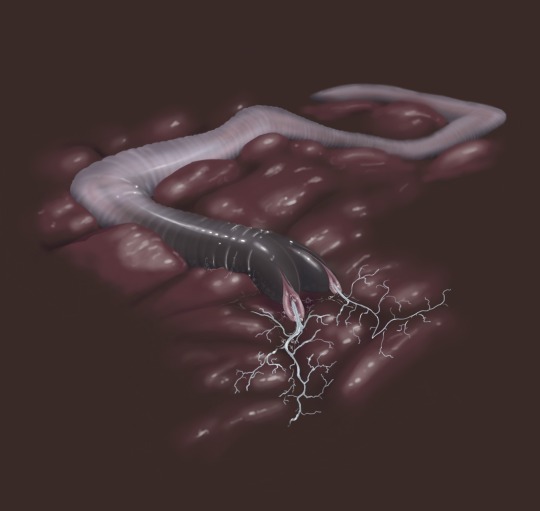
Aquifer Leech
Chaetoderma repens
These tube-like mollusks are similar to a shell-less clam or mussel. They can grow to a length of two meters and are equipped with two retractable, mucosal proboscises which branch into many thousands of microscopic tubes. These small tubes, which are able to penetrate even the densest tissues by finding microscopic fractures in its structure, sap liquid moisture from which the Leech feeds.
Aquifer Leech are typically found in well-oxygenated aquatic environments within the pit such as moisture crops and water bladders . They inhabit the soft, porous substrates of these aquatic environments, often forming large aggregations to feed on nutrient-rich organic matter suspended in the water. The Aquifer Leech also provide an important ecological service, as they help to aerate and clean the substrate of these aquatic bodies, by consuming organic material and expelling crystal clear water in the process. Aside from their ecological importance, the species have been utilized to treat water to an extremely high purity, requiring far less energy than a traditional desalination plant. Additionally, their mucosal proboscis is used in medical research as a way to perform research on the human vascular system and its response to various conditions.
#mystery flesh pit#mystery flesh pit national park#worldbuilding#horror art#unreality#horror#worldbuilding art#mysteryfleshpit#wildlife#creature
3K notes
·
View notes
Text
Round 1 - Phylum Annelida




(sources - 1, 2, 3, 4)
Annelida is a large phylum, whose animals are sometimes called the “segmented worms.” This is a large phylum containing over 22,000 living species. Annelids are made up of multiple segments, each with the same set of organs (except for the oddball Echiurans). Instead of cilia, they use fleshy protrusions called parapodium for locomotion.
Annelida is a diverse phylum with animals that have adapted to many different environments, including terrestrial, freshwater, and marine habitats from tidal zones to hydrothermal vents. It includes the earthworms, leeches, ragworms, feather duster worms, and others.
Many marine polychaete worms live in tubes they build themselves or burrow in the sand to ambush prey or filter feed, but some spend their whole lives swimming in the water column.

Propaganda under the cut:
Earthworms are important in farming and in ecology as they help aerate and enrich the soil.
The largest annelid is the endangered Giant Gippsland Earthworm (Megascolides australis), which is on average 1 m (3.3 ft) long and 2 cm (0.79 in) wide. They can reach up to 3 metres (9.8 ft) long, and they can stretch to seem much longer or contract to seem shorter.
Like earthworms, marine polychaetes also aerate the sea floor, enabling water and oxygen to reach the other creatures that live with them.
Annelids help scientists monitor the quality of water, as different species have different tolerances for water quality.
Medicinal leeches are still used for blood-letting, though not as frequently as they once were. In fact, some species of leech are threatened due to overharvesting for this purpose!
Annelids don’t fossilize well due to their soft bodies, so most fossils are simply jaws or tubes. The earliest annelid fossil that can be confidentially identified is dated to the early Cambrian, and most of our modern polychaete groups appeared by the end of the Carboniferous.
Okay so you’d still love your partner if they were a worm, but would they be your favorite animal?
#round 1#animal polls#i am so neutral about these guys EXCEPT#for Phyllodocids#because there was this one time I was watching Nautilus Live and they came across this Gossamer Worm just swimming freely in the dark ocean#twisting and turning around it was mesmerizing#and I started crying just for the wonder of it all#how blessed I am to share a planet with such amazing creatures
75 notes
·
View notes
Photo


Yarragardee Basin, Mangala, 7995 A.D.
------------------------
Accompanying music: You’re On Fire by They Might Be Giants. Summer road trip music of all time, in my opinion.
Here’s a little expository write-up on the history and geography of the worlds shown here. Someday I’ll have more to show of the personal story of these two critters and their travels; until then, a more macro-level description.
------------------------
(most of this info has become outdated as modeling invalidated some original assumptions and I changed my mind on what I wanted here; future art of Mangala will reflect this)
Mangala and its sister world Kahira (visible in the background) are binary planets, orbiting one another in a manner not entirely unlike that of Pluto and Charon in the Solar System. Mangala is a relatively small world - just about twenty percent the mass of the Earth, something like if you took two copies of Mars and smushed them together; without the internal heat to drive a carbonate cycle long term, it had long been a frozen, dusty, and arid place when transhumanity first established a permanent presence in the Tahoka system almost a thousand years ago. Since those early days, terraforming using a Birchian soletta system (a huge but foil-thin Fresnel lens of mirrors, with a secondary focal lens for burning atmospheric gasses out of the regolith) has rendered it shirtsleeve habitable to baseline humans across much of the surface, although the global water inventory remains low* and the air in the “continental” uplands is stratospheric, with only the hardiest lichens establishing a foothold. Most of Mangala’s major metropolitan areas are located in the deep rift valleys and basins, where air pressure is highest.
Kahira on the other hand, a rock almost a fifth the mass of its sister world (a little under the mass of old Mercury), remains only slightly terraformed - surface conditions are persistently cold, with a thin barely-Martian atmosphere. Some of its larger rift valleys and craters have been tented over, aerated, and planted with tall low-gravity forest and grassland, a style of habitat construction dating back to the first Mars colonists almost six thousand years ago. Industrial complexes and buried cities sprawl out across the bare surface of the moon, with huge low-gravity lava tubes seeing extensive urban development.
The Yarragardee Basin, pictured above, is a graben basin in Mangala’s northern hemisphere, notable for the historic industrial city of Tirupati - here we see two road-trippers between cities on the basin’s great plain, taking a break in the long late afternoon of a sunset-day***. Having stopped for a night at a motel near Tirupati’s aerospace complex, they’re now continuing their journey to the city of Redmond-Tonasket, located in the Woronora Valles trench system about two thousand kilometers to the southwest.
* While plenty of water could have been imported from Tahoka’s cometary halo, it was decided not to do so in order to avoid inundating pre-existing cities in the valleys and deep basins. The extremely humid hothouse conditions that come after slamming dismantled ice moons through the stratosphere at over six kilometers a second were also broadly considered unacceptable.
** Smaller worlds have been terraformed in transhuman space, both by worldhouse and more open-air methods, but it’s largely the kind of thing that much more energy-rich systems do as a vanity project. Kahira may someday see blue skies, but likely not for a thousand years at least. (edit, one year later: I actually changed up some of this while simulating this system for stability. I’ll be posting more about this soon.)
*** Mangala and Kahira, being tidally locked to each other such that they always show one another the same face as they orbit their common center of mass, both have days exactly as long as their orbital periods - 403 kiloseconds, or roughly 112 hours. This is for convenience divided into month-weeks comprising four “circadian days” of 100 kiloseconds (~26 hours), with the remaining three kiloseconds added on to the last day of a month-week to keep synchronization.
594 notes
·
View notes
Text
okay okay lemme just explain this real quick because oh my dark gaia i have so much to say about the aerated bread company
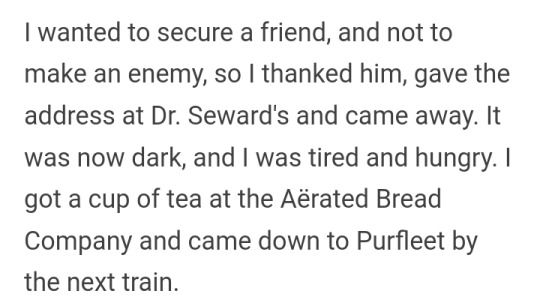
okay to start it off, the aerated bread company was originally a bakery chain in london known for a special method of making bread with machines that skipped the fermentation process used by most bread makers at the time by putting carbon dioxide into the process and producing carbonic acid gas.
this very element of the aerated bread company was widely debated as some people saw the way the bread was now kneaded by machinery and made quickly with carbon dioxide as a step into the future and some saw it as an abandoning of the traditional ways of bread making.
john dauglish, the inventor of the method and founder of the company, received an patent for the method in 1856, received a silver medal from the royal society of the arts, and had his methods highly recommended by many physicians and sanitarians at the time, even using the method in hospitals due to the cleanliness of the machine bread. the process was also cheaper and made it so the company could sell it at lower prices than other london bakeries. it was so well received that even americans were fascinated by the dauglish bread making process. while it is no longer used today, the process lasted for a century or so before being replaced by the chorleywood bread process which is now still in use today.
not everyone was a fan however. many classic bakers saw the innovation as a blasphemy to the way bread was supposed to be done. they believed that fermentation was the only way to make bread and that by taking that and hand kneading out of the process, the aerated bread company was doing a disservice to the art as a whole. traditional bread makers, in order to combat the cheapness of the aerated bread company's bread, marketed their usage of gin in their traditional bread as it was thought to have medical benefits at the time due to the juniper berries fermented to make it. despite this however, the aerated bread company continued to be popular with rapidly rising stocks and continued demand with bakery after bakery opening in the area
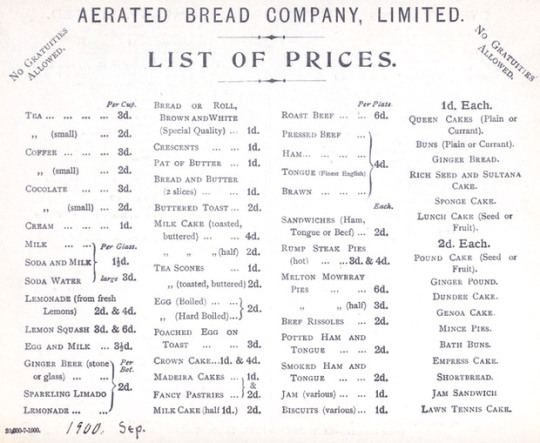
however, bread wasn't the only thing made by the aerated bread company as you may have figured out from this short mention. in 1864 they opened their tearoom in fenchurch street railroad station and the chain only grew from there. many things were offered in addition to tea as you can see from the menu above. at the aerated bread company's peak in 1923 they had 250 tea shops in london, other towns in england, and even sydney, australia!

just like the bread-making process that gave the aerated bread company it's name however, the tea shops had quite a bit of controversy. one of the biggest things going for them was the stores involvement in the women's right movement (making this particular choice of tearoom interesting at a time when mina is currently being disregarded by the men in her life) the tearooms were one of the first public places in victorian england where women could eat alone or with women friends, without a male escort. women's social clubs would even be set up above the shops in a few rare instances. this was complicated slightly by the poor payment of women workers by the company, they did not even originally pay women workers which eventually changed when protest was raised by women who frequented the tearooms. despite this, it was recommended by women's rights activists as a good place to organize and socialize without male escorts.
not everyone liked the tearooms though. one particularly bitter opponent to the tearooms was george orwell, author of books such as animal farm and nineteen eighty four. he stated on the shops that they were a "sinister strand in English catering, the relentless industrialisation that was overtaking it...everything comes out of a carton or a tin, or is hauled out of a refrigerator or squirted out of a tap or squeezed out of a tube" also one customer in a sydney tearoom claimed to have found a mouse baked into her pie, sueing for a thousand euros. the claim was found to be faked and the judge did not rule in her favor but it was still interesting
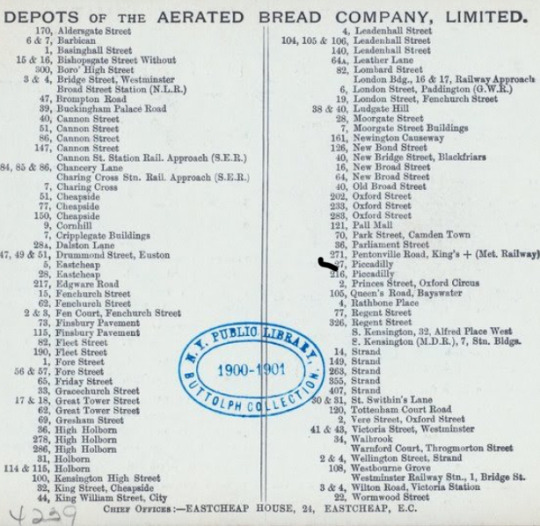
what happened to the aerated bread company? well, it did very good for a long period of time but like all good things (or at least somewhat good things) it came to an end. nothing really interesting happened in its closing, parts of it were liquidated in other countries and it was bought by the allied bakeries in 1955. the company ceased operations fully in 1982 and now all that is left of the aerated bread company are the ghosts of signs left over the doors to other shops.
and that's the aerated bread company for the interested!
#dracula#dracula daily#mina harker#jonathan harker#i really care about this subject for no reason so here you go
1K notes
·
View notes
Text
Hey, got the Goo Gone, let's de-gunk your tube, Norm!
Thanks, Jenny. I still feel kinda bad. I was always supportive of Judy, so I don’t want to seem like I’m ungrateful.
Well, if you wanted, I did grab you another sticker, I figured we could put it on the side of your aerator or your voice synthesizer; spruce it up a little, you know?
"I Love My Trans Daughter.” Awww. Jennyyyyy.
Look, don't, like, make a big deal out of it, ok? I got one for Knight, too.
We never had kids so—
Nooooorm, can you be cool about, like, ONE thing, ever?
Means a lot, Jennster. Do I get to say that now?
I...don't hate it.
33 notes
·
View notes
Text
Chastity
The chastity cage, a standard issue for recruits, boasted a design that seamlessly integrated with the advanced technology of the Armour Suits.

Material: Nano Plastics and Ceramics
Dual-Chamber Design: Separation for Testicles and Penis
Locking Mechanism: Secure yet easily accessible for hygiene and maintenance
Anti-Tamper Sensors: Alerts the AI in case of unauthorized attempts to manipulate the device
Temperature Control: Maintains a comfortable temperature within the chambers
Aeration System: Allows for ventilation to prevent moisture and ensure skin health
Customizable Restraint Levels: Adjustable settings for varying degrees of security
Medical-Grade Monitoring: Monitors physiological health and provides feedback to the wearer
Compatibility: Integrates seamlessly with Armour Suit technology and HUD interfaces
Hygienic Seals: Ensures cleanliness and reduces the risk of infection
Comfort Padding: Medical-grade silicone for extended wear
Adjustable Fit: Customizable sizing to accommodate individual anatomical variations
Durability: Resistant to corrosion, impact, and extreme environmental conditions
Charging: Wireless induction charging for convenience
Compliance: Meets Tactical Paramedic Corps regulations for personal equipment
This state-of-the-art chastity cage goes beyond mere physical restraint, incorporating advanced technologies to ensure both security and the well-being of the wearer. Its dual-chamber design, combined with biometric authentication and anti-tamper features, establishes a new standard for personal discipline within the Tactical Paramedic Corps.
Shielded from external access, both the penis and testicles find residence in specially designed chambers crafted from premium silicone rubber. The surface texture mimics natural skin, ensuring a comfortable fit without leaving any discernible pressure marks. Within this chamber, a clear division accommodates the separate housing of the penis and testicles. The penis tube takes on a downward-bent configuration for optimal comfort.
Dedicated protection is afforded to the testicles through an independent chamber, shielding against pinching and providing a cooling effect. The larger size, complemented by a more spacious tube, enhances overall comfort. Additionally, ample room for expansion is available to prevent any sense of constraint in case of enlargement.
When nature calls, there's no requirement to unlock the belt. The penis tube seamlessly connects to an opening at the bottom of the belt. To prevent any potential blockage caused by an erect penis, a reservoir ensures the discharge point remains unobstructed.
The chastity belt integrates seamlessly with the armor suit's docking system through a specialized interface mechanism. The belt is equipped with a proprietary docking port that aligns precisely with the corresponding receptacle on the armor suit. This connection is established using a secure locking mechanism that ensures a robust and tamper-proof link.
This connection not only facilitates power transfer and data exchange but also ensures the proper functioning of integrated systems.
Upon docking, a series of verification protocols are initiated, confirming the integrity of the connection and the operational status of both the chastity belt and the armor suit.
Upon initiating the waste evacuation procedure, the integrated systems work in tandem to ensure a seamless and controlled process. The docking mechanism guarantees a reliable connection, allowing for the unhindered flow of waste from the chastity belt to the designated disposal system within the armor suit.
This comprehensive solution contributes to the overall functionality of the armor suit, addressing the physiological needs of the wearer while maintaining the discretion and efficiency required in operational environments.
The chastity cage is designed with versatility in mind, allowing it to be worn independently of the armor suit. Its standalone functionality ensures that the wearer can maintain the constraints and security provided by the chastity cage even when not in the complete armor suit ensemble.
Constructed from durable nano plastics and ceramics, the chastity cage provides a discreet and comfortable fit. The dual-chamber design, featuring separate compartments for the penis and testicles, ensures security and protection while offering a natural feel against the skin.
Whether worn as part of the complete armor suit or independently, the chastity cage remains an integral component, aligning with the established protocols and regulations governing the paramedics' conduct and attire
The uniformity enforced by the chastity cage contributes to the overall professionalism of the paramedics. It aligns with the standards set by the Corps, fostering a sense of discipline and uniformity among the tactical medical team.
The dual-chamber design ensures that the genitals are securely enclosed, reducing the risk of contamination or injury in the field.
By eliminating concerns related to personal needs, the paramedics can maintain a focused and concentrated mindset during critical situations. The chastity cage's design allows for seamless waste evacuation without compromising operational efficiency.
16 notes
·
View notes
Note
Can you show how you made the aerochamber?
Hell yeah!!
Supplies:
- cardboard tube (tp tube, or paper towel tube if you don't wanna use something that was by your toilet)
- if paper towel tube, scissors to cut it
- tape
- your inhaler for size reference
Take your paper tube and cut it to the appropriate size if it's big
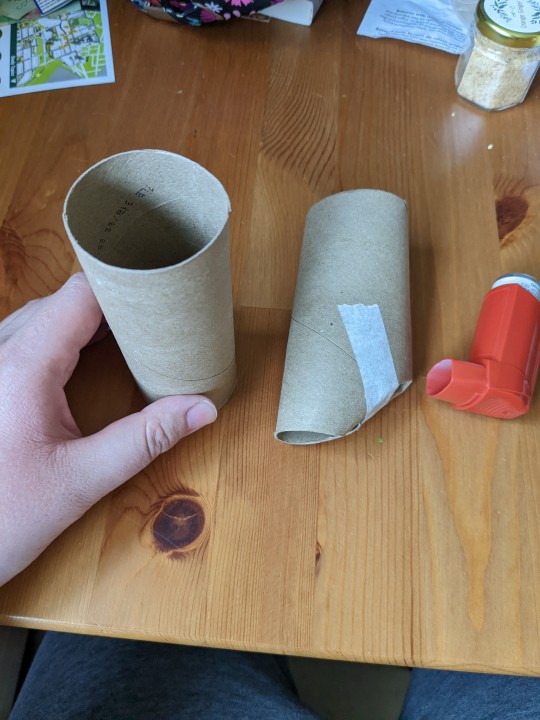
[ID: a photo of two toilet paper tubes, one of which has been taped into a makeshift aerochamber, sitting on my table by my hand and a flovent inhaler.]
You're gonna fold in one end of the paper tube, making it smaller, using your inhaler for size - ideally, you want it to fit snugly but so that it's easy to get in/out.

[ID: the photo shows my hand holding one paper tube. I have pinched in one end, making the circular opening smaller but not blocking it. It's about the size of the mouth of my inhaler now. End ID.]
The tape it in place!

[ID; the same tube, now with the fold taped in place. End ID.]
Ta-da! Very makeshift aerochamber.

[ID: a photo of the makeshift paper tube aerochamber attached to the mouth of my inhaler. End ID.]
Like, obviously this isn't as good as a real aerochamber - but for the purpose of "aerating the medication so you can inhale it rather than have most of it hit the back of your throat" it works decently well! To use it I just stick the end of the paper towel tube over my mouth and use my inhaler.
(for those unfamiliar, inhaler medication needs air to mix with to work - if you're just sticking the inhaler in your mouth and using it that way, the medication hits the back of your throat rather than going into your lungs and is apparently significantly less effective. So this is a good makeshift alternative.)
The pharmacist who suggested a makeshift one suggested a paper cup or red solo cup with a space for my inhaler cut out of the bottom, and then you seal the mouth of the cup over your mouth/chin. So that would be another option! This was just easier for what I had in my house.
Hope that helps! Thanks for the ask pal!
78 notes
·
View notes
Note
Red alert must be freaking out so much poor thing 🤣
I can perfectly imagine him being forced to go to sleep, only to wake up really scared because his abdomen is hurting and finding baby Tfa red alert, between his legs, giving her opinion
Aksjskaka poor Red Alert wakes up more than halfway through labor, already crowning and body doing it's own thing to push her out. She's delivered fully less than 2 kliks after and only Primus knows how he managed to sleep through the initial contractions. It's such an odd sensation, feeling a sparkling's shoulders, then body, then little legs pass through him
At first, there's silence. Red is hyperventilating, scrambling to turn on the lights. He knows what just happened, his legs are numb and shaking and his sensory horns are sparking, and it's happened to enough members of the ark. He knows. But his baby is silent. He's terrified, mind immediately jumping to the worst possible situations. It's stillborn, or- or it's aeration tubing is clogged with fluid, or-
He turns on the lights and sees the tiny sparkling lying deathly still in a puddle of fluid. Their optics are closed. They're not moving.
"Oh no...!" He rushes over to them, servos hovering anxiously above their body. "No no no... what do I do, wh-what should I- no please Primus don't do this-!"
Ratchet gets a hysterical call at 3 in the morning and at first he thinks it's more of Red Alert's paranoid delusions but then he hears the head of security sob and choke out, "Th-They're not moving, Ratchet! My baby's not moving!" and he practically teleports to Red's room. Medically overrides the door to force his way in and finds him with a still and silent sparkling in his arms.
He immediately takes the tiny, slimy bundle from him and scans for vitals. And wouldn't you know it, her spark pulse is fine. Her systems are all functioning. What...?
Carefully, he props the newborn against his shoulder and gently smacks her bottom. Nothing. Pats her back. Nothing. Even pinches the heel of her pede. Nothing. Red is hysterical, demanding to know why he's not doing anything, please save his sparkling!
Turns out, she's just stubborn. Not every baby comes out screaming, and she's a surprisingly peaceful, surprisingly stubborn newborn. In fact, she refuses to cry or even open her optics until Ratchet has to stick her with a needle to get an energon sample. Then, oh boy, here come the tears. Red Alert heaves the biggest sigh of relief when she screams, beginning to wail like the world is ending and squirming to get away from the medic. Her EM field, previously tightly tucked against her body, flares out in a desperate bid to find her mother, find protection from the scary mech hurting her!
Red scoops her up and kisses her still-sticky helm a thousand times, crying tears of relief as he thanks Ratchet over and over for "saving" his sparkling. He's gotten so attached in the 5 kliks he's had his precious baby bean, and can't stand the idea of losing her. The medic explains that she's fine, and is in fact really healthy: some babies just don't cry when they're born. "She must feel really safe with you, Red. That's why she was so calm." Silly girl was born asleep XD
The statement makes Red Alert blink in surprise though. "She?!" He gapes. "Wait, i-it's a-?!"
"Yes indeed. Congratulations, you have a daughter."
Red Alert is amazed. Having a girl is so rare! Only 1 in every 13 sparklings is a femme, he's so fortunate! He has no idea what he's going to call her, but he couldn't be happier regardless 🥰 he can't wait to introduce her to Inferno!
#reincarnation au#red alert#sorry this kinda got away from the original ask but i was inspired!#this was actually inspired by a cousin of mine. she was so quiet and still when she was born her mom was convinced she was dead#but no. she was just stubborn. she didnt cry until they took her blood
11 notes
·
View notes
Text
Enhancing Aquaculture with Aeration: The AirOxi Scorpion Aerator
Introduction: Aeration plays a pivotal role in maintaining the health and productivity of aquaculture ponds. Effective aeration ensures optimal oxygen levels, which are crucial for the survival and growth of aquatic organisms. Among various aeration methods, the AirOxi Scorpion Aerator stands out as a cutting-edge solution tailored for aquaculture needs. In this blog, we delve into the significance of aeration in aquaculture and explore how the AirOxi Scorpion Aerator offers substantial benefits for pond management and fish farming.

Understanding Aeration in Aquaculture: Aquaculture ponds, whether used for fish farming or shrimp cultivation, require adequate oxygen levels to support aquatic life. Oxygen is vital for fish respiration, decomposition of organic matter, and the maintenance of water quality. Insufficient oxygen levels can lead to stress, reduced growth rates, and even mortality among aquatic organisms. Factors such as high stocking densities, warm temperatures, and excessive organic load can further exacerbate oxygen depletion in ponds.

Aeration serves as a primary means to address oxygen deficiencies in aquaculture ponds. By introducing air into the water, aeration enhances oxygen transfer and promotes circulation, thus mitigating stratification and maintaining uniform oxygen distribution throughout the pond. Additionally, aeration facilitates the removal of harmful gases such as carbon dioxide and hydrogen sulphide, which can accumulate in stagnant water.

The AirOxi Scorpion Aerator: A Revolutionary Solution: The AirOxi Scorpion Aerator represents a breakthrough in aeration technology tailored specifically for the aquaculture industry. Unlike traditional aerators that rely on mechanical agitation or surface splashing, the AirOxi Scorpion utilizes fine bubble aeration, delivering a multitude of tiny bubbles that efficiently oxygenate the water column.
Key Features and Benefits:
Fine Bubble Aeration: The AirOxi Scorpion generates fine bubbles with a diameter ranging from 300 to 700 microns. These fine bubbles have a large surface area-to-volume ratio, facilitating rapid oxygen transfer and dissolution in water. As a result, aquatic organisms receive a steady supply of oxygen essential for their growth and well-being.
Energy Efficiency: One notable advantage of the AirOxi Scorpion Aerator is its energy-efficient operation. By utilizing low-pressure blowers or compressors, it achieves optimal aeration without excessive power consumption. This energy-saving feature not only reduces operational costs but also promotes sustainability in aquaculture practices.
Uniform Aeration: The AirOxi Scorpion's innovative design ensures uniform distribution of oxygen throughout the pond, eliminating oxygen gradients and preventing localized oxygen depletion. This uniform aeration promotes better water quality and creates an optimal environment for fish and other aquatic species.
Low Maintenance: Designed for reliability and longevity, the AirOxi Scorpion Aerator requires minimal maintenance compared to conventional aerators. Its durable construction and corrosion-resistant materials make it suitable for continuous operation in diverse aquaculture environments.
Scalability and Versatility: Whether used in small-scale fish ponds or large commercial aquaculture facilities, the AirOxi Scorpion Aerator offers scalability to meet varying demands. Moreover, it can be integrated with existing pond management systems or deployed as standalone units, providing flexibility and ease of installation.
Conclusion: In conclusion, aeration plays a critical role in optimizing water quality and ensuring the success of aquaculture operations. The AirOxi Scorpion Aerator emerges as a game-changer in the realm of pond aeration, offering unparalleled efficiency, reliability, and performance. By harnessing the power of fine bubble aeration, this innovative technology enhances oxygenation, promotes uniform water circulation, and fosters a conducive environment for aquatic life. As aquaculture continues to evolve, solutions like the AirOxi Scorpion Aerator pave the way for sustainable and profitable fish farming practices.
Contact AirOxi for your aquaculture aeration requirements
+917041004098
www.buy.airoxi.com
#fish farming#shrimp farming#aquaculture#airoxitube#aeration#airoxi#aeration tubes#aeration solution#airoxi tube#fish
0 notes
Text

INDPRO is a proudly Indian manufacturing company that makes most effective and cost optimized Vibratory Feeder Conveyor Vibratory Tube Pan Conveyor Indore
#vibratory tube feeder#Vibrating Aerators#vibratory conveyor#vibratory feeder#vibratory spiral conveyor#vibratory spiral elevator#vibrating bin discharger#vibratory pan conveyor#Vibrating bin aerator#vibratory tube conveyor
0 notes
Text

PASTI HEMAT DIFFUSER FINE BUBBLE HUB:(081335353290)
Diffuser fine bubble adalah perangkat yang digunakan dalam pengolahan air untuk menghasilkan gelembung kecil berukuran seragam. Perangkat ini
dirancang khusus untuk memperbaiki kualitas air dengan menyediakan oksigenasi yang efisien bagi organisme hidup di dalamnya.
Diffuser fine bubble bekerja dengan memecah udara atau gas lainnya menjadi gelembung kecil dengan ukuran seragam, umumnya kurang dari 2
milimeter. Kelembaban yang dihasilkan sangat tinggi, menciptakan luas permukaan kontak antara udara dan air. Dalam aplikasinya, gelembung kecil ini
menyebar secara merata di dalam air, membawa oksigen ke dalamnya dan memfasilitasi proses aerasi.Keunggulan diffuser fine bubble adalah kemampuannya
untuk meningkatkan transfer oksigen ke dalam air secara efisien, menghasilkan tingkat oksigenasi yang optimal bagi organisme akuatik seperti ikan dan
mikroorganisme. Dibandingkan dengan gelembung yang lebih besar, gelembung kecil ini memiliki waktu tinggal yang lebih lama di dalam air, sehingga mampu
meningkatkan efisiensi transfer oksigen.
Perangkat ini sering digunakan dalam berbagai aplikasi, termasuk pengolahan air limbah, akuakultur, dan sistem pemurnian air. Penggunaan diffuser fine bubble
membantu meningkatkan kualitas air, mengurangi tingkat polutan, dan mendukung pertumbuhan organisme hidup di dalamnya.Dengan teknologi yang terus berkembang,
diffuser fine bubble juga dapat dikombinasikan dengan sistem kontrol yang cerdas untuk mengoptimalkan kinerjanya, termasuk kontrol suhu, tingkat oksigen, atau
bahkan distribusi gelembung secara spesifik di area tertentu.
Untuk pembelian bisa anda kunjungi link dibawah ini:
Shopee:https://shopee.co.id/Air-Diffuser-Fine-Bubble-Disc-10-Inch-i.749609936.15280185273?sp_atk=219b75b4-27d6-4b0c-9fad-ac6c0fa4f896&xptdk=219b75b4-27d6-4b0c-9fad-ac6c0fa4f896
Tokopedia:https://www.tokopedia.com/heframid/air-diffuser-fine-bubble-air-disc-10-inch?extParam=src%3Dshop%26whid%3D13549232
Atau bisa hubungi toko kami lewat no:081335353290
diffuser fine bubble,fine bubble tube diffuser,fine bubble air diffuser,fine bubble diffuser design,fine bubble diffuser price
#diffuser fine bubble#aeration diffuser fine bubble#fine bubble diffuser specifications#fine bubble tube diffuser#fine bubble disc diffuser#fine bubble air diffuser#fine bubble diffuser design#fine bubble diffuser adalah#fine bubble diffuser price
0 notes
Text
A poem by Gail McConnell

Worm
Burrowing in your allotted patch you
move through the dark, muscles contracting one by one
in every part, lengthening and shortening
the slick segmented tube of you, furrows in your wake.
Devising passages for water, air,
you plot the gaps that keep the structure from collapse.
Dead things you know. Plants and creatures both.
Your grooves shift matter, sifting as you go.
Eyeless, your appetite aerates.
Eating the world, you open it.
You ingest to differentiate.
Under the foot-stamped earth, you eat into a clot
of leaf mould, clay and mildew, and express what you can
part with, as self-possessed as when you started.
Your secretions bind the soil,
your shit enriches it. How things lie
now will be undone, will reoccur. You, a surface-level archivist
sensing all there is
can be gone through. The body borne
within its plot.

Gail McConnell
Listen to Gail McConnell read her poem.
9 notes
·
View notes
Text
youtube
Jude constructs a hot compost bay layered with the perfect ingredients to feed a productive patch.
On a sloping block in the Blue Mountains, Jude has many projects on the go. To keep the garden cranking, Jude’s been learning a lot about compost. “This stuff is gold,” says Jude, “it adds nutrients, water and is the life of the soil.” Here’s how to construct a hot compost bay to feed a productive patch.
The Built Structure:
Jude’s two-bay compost system can house about two cubic metres and was constructed with the help of a mate. They’ve used recycled pallets which are heat treated to make sure the compost is safe to put on edible produce. It has gates at the front, low enough for a wheelbarrow, and is clad with corrugated iron. Jude says the corrugated iron “makes a really good backing when you're digging into the compost, and they also heat it up.” It’s a good idea to install a chicken-wire tube in the centre of the bay for airflow.
Compost is broken down organic matter and is full of nutrients that plants thrive on. Organic matter is anything that was once alive, like plants, animals, and even manures. This material can be broken down slowly by worms in a cool compost system, but in a hot compost system, it’s broken down by millions of micro-organisms and fungi. A big mass of material paired with a lot of microbial action generates a lot of heat. Jude says, “hot compost is a great way to get a lot of compost in a very short amount of time.”
Hot compost needs to be built it all in one go, at least one cubic metre in size. Jude says smaller composts “won't generate the heat required to breakdown the organic matter.” The ideal temperature for hot compost is 60°C, anything higher is way too hot to support the microbes. Regular turning for airflow will help manage the temperature. Jude’s got the perfect ingredients for a healthy hot compost habitat to provide these critters food, air and moisture.
Green & Brown Materials:
Good compost has “a mix of greens and browns,” says Jude. Brown layers are carbon-rich material such as cardboard, sticks, newspaper and straw. These offer energy to the microbes, absorb moisture and improve airflow. Green layers are not always green in colour. Greens are nitrogen-rich materials such as grass clippings, coffee grounds and food scraps. Jude says, “as a general rule of thumb, you want at least twice as much of the carbon-rich material as the nitrogen-rich green stuff.”
Layer #1: Brown:
Cover the base with a carbon layer of sticks and twigs. The rough textures allow excess water to drain, will bulk out the base and help oxygen get into the pile. Jude says, “when I'm adding a layer of carbon, I'm watering it in. I'm aiming for a pile that's moist but not soaking wet.” A layer of wet newspaper on top of the twigs will help create this environment.
Layer #2: Green:
Repurpose your old kitchen scraps and leafy garden waste. Jude says, “avoid meat, bread and dairy” to keep rodents away, and make sure you’re “not adding any weeds with seeds, bulbs or runners.” Break big sections up with a spade to help it breakdown faster. Jude says, “adding diverse nutrients like comfrey will help fire up microbial life.”
Layer #3: Brown:
A thick layer of straw mulch will act as a blanket for all that heating mass underneath. In two weeks, this pile can be lifted and moved into the second bay and turned every few weeks. Check the pile regularly to see if it needs more water or aeration.
You’ll know it's ready when it begins to look like yummy crumbly chocolate cake. Like the one Jude’s brother Charlie was inspired to make - what a team!
#gardening australia#solarpunk#compost#how to#how to make compost#diy#do it yourself#hot compost#hot compost system#Youtube
3 notes
·
View notes
Text
How does ETO Sterilization work?
What is ETO Sterilization?
Ethylene oxide (ETO) sterilization is a process used to sterilize medical and pharmaceutical products that cannot withstand traditional high-temperature steam sterilization methods. ETO is a gas that effectively kills microorganisms such as bacteria, viruses, and fungi by disrupting their DNA and cellular proteins.

How Does ETO Sterilization Work?
Preparation: Items to be sterilized are placed in a sealed chamber.
Exposure: ETO gas is introduced into the chamber, reaching all surfaces of the items.
Conditioning: The gas is held at specific temperature, humidity, and pressure levels for a predetermined time to ensure effective sterilization.
Aeration: Post-sterilization, the chamber is aerated to remove residual ETO gas, as ETO is toxic and potentially carcinogenic.
Monitoring: Throughout the process, parameters such as gas concentration, temperature, and exposure time are closely monitored to ensure efficacy and safety.
Applications of ETO Sterilizers
ETO sterilization is particularly suitable for:
Medical Devices: Such as surgical instruments, implants, and catheters.
Pharmaceuticals: Including drugs, ointments, and powders that are sensitive to heat and moisture.
Packaging Materials: Like plastic pouches and tubes that cannot withstand high temperatures.
Its ability to penetrate porous materials and complex devices makes ETO sterilization indispensable in many healthcare and pharmaceutical settings where other methods might be impractical or ineffective.
Considerations and Safety
While highly effective, ETO sterilization poses certain safety challenges:
Toxicity: ETO is hazardous to human health and requires careful handling. Workers must be trained in its safe use, and facilities must have adequate ventilation and monitoring systems.
Residuals: Proper aeration is crucial to remove ETO residues, which can otherwise compromise product safety.
Regulatory Compliance: Due to its potential health risks, ETO sterilization is heavily regulated by health authorities and environmental agencies worldwide.
Future Trends and Innovations
As technology advances, efforts are underway to improve the efficiency and safety of ETO sterilization processes. This includes developments in gas monitoring systems, aeration techniques, and automation to minimize human exposure.
Conclusion
ETO sterilization plays a critical role in ensuring the safety and efficacy of medical and pharmaceutical products that are sensitive to heat and moisture. While it requires careful handling due to its toxicity, advancements in technology continue to enhance its reliability and safety. As healthcare and pharmaceutical industries evolve, ETO sterilization remains a cornerstone in the arsenal of sterilization methods, ensuring that healthcare providers and patients alike can trust in the sterility of essential medical products.
Top ETO Sterilizer Manufacturer in India
If you are looking for Best ETO Sterilizer Manufacturer in India, look no further than Instech Sytems, we are a leading manufacturer and supplier of ETO Sterilizer in India.
For more details, please contact us!
Website :- www.cssdtechnologies.com
Contact No. :- +91–8896456000 , +91–9873069138
Email :- [email protected]
#ETO Sterilizer manufacturer#ETO Sterilizer manufacturer in India#Top ETO Sterilizer supplier in India#Best ETO Sterilizer manufacturer in India#Instech Systems
2 notes
·
View notes